
Sibelius then decided he wanted the premiere to be in Helsinki, which is understandable, as it was financially beneficial for him and he was Finland’s preeminent nationalist composer. Sibelius originally had planned to dedicate the work to the esteemed German violinist, Willy Burmester, who had agreed to premiere it in Berlin. Tales of alcoholism, or at least drinking far too much, are rampant, and there is an anecdote that his wife had to go searching for him at a local pub to prompt him to finish writing the third movement for the Violin Concerto’s premiere. In 1903, Sibelius was in one of his more compositionally prolific periods, but he was troubled. The Violin Concerto’s composition and premiere was a turbulent path filled with delays, disasters, and ill-will. Most of Sibelius’s main works are written for the orchestral realm, yet only one concerto was written, and that was for the instrument he loved so dearly. My preference for the violin lasted quite long, and it was a very painful awakening when I had to admit that I had begun my training for the exacting career of an eminent performer too late. I hated pen and ink, and, unfortunately, preferred an elegant violin bow. From the age of fifteen, I played my violin for ten years, practicing from morning to night. My tragedy was that I wanted to be a celebrated violinist at any price. He was crushed upon his reluctant admission that it was not meant to be: Sadly, he got a late start in his studies on the instrument, and while most accomplished, just didn’t possess the technical dexterity or intestinal fortitude required of a master violinist. As a teen he had dreamed of being a violin virtuoso and had practiced diligently toward that lofty goal. Sibelius’s Violin Concerto was perhaps conceived as a gift to his younger self, so wrought with disappointment. Jean Sibelius Violin Concerto in d minor, op. The March vacillates between soaring melody and use of military elements such as dotted rhythms, and sections heavily featuring the brass, percussion, and piccolo in the more rousing sections.

The “Alla marcia” movement is a stirring call to battle that depicted a castle siege in the original production. The Overture from the original Karelia was published separately. He used the fourth, fifth, and sixth tableaux to create a three-movement suite comprised of movements entitled Intermezzo, Ballade, and Alla marcia. Sibelius wisely wondered if the music itself might not translate without the drama and scenery of its original corresponding tableaux, so he extracted a suite from the Karelia music. The music was quite well received and was popular briefly after the pageant as well. Sibelius’s original music written for the Karelia pageant consisted of an overture and eight movements that corresponded with the dramatic, staged tableaux. The pageant took place on November 13, 1893, in Helsinki, and was such a success that the event was completely sold out and people were turned away. This was a particularly patriotic time in Finland as Russia was striving to rid Finland of its cultural individuality, beginning in earnest just six years later with the “Russification of Finland.” Sibelius’s commission was to write music that would accompany staged tableaux depicting some of Karelia’s most dramatic and historical moments. The group was putting on a pageant-type event celebrating Karelia, two small regions in southeast Finland and the land that lies to the east of Finland and west of the White Sea. It came from the Viipuri Student Corporation at the University of Helsinki. Sibelius’s Karelia Suite was his first commission for nationalist music. There was no turning back, Sibelius was now a nationalist composer, and shouldered all the responsibility that comes with composing for a nation.

The work was inspired by a collection of poetry from Finnish and Karelian sources. Jean Sibelius rose to fame in Finland in 1892 with his successful tone poem, Kullervo for chorus, orchestra, and vocal soloists. (Born 1865, Hämeenlinna, Finland died 1957, Järvenpää, Finland)

Jean Sibelius “Alla marcia” from Karelia Suite, op. Program Notes, ©2013 Lori Newman Program Notes
#Program notes shostakovich symphony 6 archive#


 0 kommentar(er)
0 kommentar(er)
